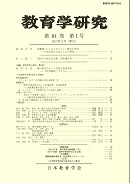
- Issue 4 Pages 419-
- Issue 3 Pages 283-
- Issue 2 Pages 137-
- Issue 1 Pages 1-
- |<
- <
- 1
- >
- >|
-
Sunji LEE2018 Volume 85 Issue 1 Pages 1-12
Published: 2018
Released on J-STAGE: October 17, 2018
JOURNAL FREE ACCESSThe purpose of this paper is to reveal the relation between attention and media by examining Bernard Stiegler's discussion thereof. Of late, the relation between attention and medium has become a major issue in various fields due to the fact that some gadgets, for instance smartphones, are able to affect people's attention. However, in pedagogy, according to Yasuo Imai, attention has been considered as a part of “actively engaging in seeking and selecting materials” because of the influence of John Dewey. As a result, attention has not been a major issue under influence of new educational ideologies. As mentioned above, the purpose of this paper is to examine the relation between attention and media by referring to Stiegler's approach to attention. This examination will make it clear that media and practices in education, such as literature literature/language arts education, intended to improve attention contradict themselves as they contain multitudes.
First, this paper examines Stiegler's critique of Edmund Husserl, based on the idea that Husserl opposes “primary retention” for “secondary retention”. According to Stiegler, primary retention should be distinguished from secondary retention, while at the same time, they can never be opposed. While the stream of consciousness is directed toward the future, it recalls its past. That is to say, the “present” of consciousness is always already affected by its memory. Therefore, Stiegler argues for the need to understand consciousness as a “swirl”.
In addition, Stiegler focuses on “tertiary retention” as a supplement of primary retention and secondary retention. Tertiary retention indicates images, sketches, pictures and so on. Briefly speaking, it is media. Stiegler mentions that attention cannot be actualized without medium, and thus attention can be fundamentally influenced by some media. Therefore, some media can affect people's attention. More importantly, the reflected attention which Dewy reduced to “actively engaging” is also fundamentally supported by media.
Finally, based on the above, Stiegler proposes the reexamination of education for improvement of attention with media, for example education in literature and language arts. According to Stiegler, this subject forces students to “internalize discipline,” while at the same time it enables students to criticize this discipline. Therefore, we should reexamine education with media in order to reveal these contradictory multidimensions.
View full abstractDownload PDF (410K)
-
Haruo AUCHI2018 Volume 85 Issue 1 Pages 13-32
Published: 2018
Released on J-STAGE: October 17, 2018
JOURNAL FREE ACCESSDownload PDF (507K)
-
Katsumi TOBINO2018 Volume 85 Issue 1 Pages 33-41
Published: 2018
Released on J-STAGE: October 17, 2018
JOURNAL FREE ACCESSDownload PDF (422K)
-
Masamichi UENO2018 Volume 85 Issue 1 Pages 42-50
Published: 2018
Released on J-STAGE: October 17, 2018
JOURNAL FREE ACCESSDownload PDF (500K)
-
2018 Volume 85 Issue 1 Pages 51-58
Published: 2018
Released on J-STAGE: October 17, 2018
JOURNAL FREE ACCESSDownload PDF (363K) -
2018 Volume 85 Issue 1 Pages 59-66
Published: 2018
Released on J-STAGE: October 17, 2018
JOURNAL FREE ACCESSDownload PDF (373K)
-
2018 Volume 85 Issue 1 Pages 67-70
Published: 2018
Released on J-STAGE: October 17, 2018
JOURNAL FREE ACCESSDownload PDF (80K) -
2018 Volume 85 Issue 1 Pages 71-79
Published: 2018
Released on J-STAGE: October 17, 2018
JOURNAL FREE ACCESSDownload PDF (392K)
-
2018 Volume 85 Issue 1 Pages 80-82
Published: 2018
Released on J-STAGE: October 17, 2018
JOURNAL FREE ACCESSDownload PDF (213K)
-
[in Japanese]2018 Volume 85 Issue 1 Pages 83-85
Published: 2018
Released on J-STAGE: October 17, 2018
JOURNAL FREE ACCESSDownload PDF (536K) -
[in Japanese]2018 Volume 85 Issue 1 Pages 85-87
Published: 2018
Released on J-STAGE: October 17, 2018
JOURNAL FREE ACCESSDownload PDF (535K) -
[in Japanese]2018 Volume 85 Issue 1 Pages 88-90
Published: 2018
Released on J-STAGE: October 17, 2018
JOURNAL FREE ACCESSDownload PDF (535K) -
[in Japanese]2018 Volume 85 Issue 1 Pages 90-93
Published: 2018
Released on J-STAGE: October 17, 2018
JOURNAL FREE ACCESSDownload PDF (540K) -
[in Japanese]2018 Volume 85 Issue 1 Pages 93-95
Published: 2018
Released on J-STAGE: October 17, 2018
JOURNAL FREE ACCESSDownload PDF (534K) -
[in Japanese]2018 Volume 85 Issue 1 Pages 95-97
Published: 2018
Released on J-STAGE: October 17, 2018
JOURNAL FREE ACCESSDownload PDF (535K) -
[in Japanese]2018 Volume 85 Issue 1 Pages 97-100
Published: 2018
Released on J-STAGE: October 17, 2018
JOURNAL FREE ACCESSDownload PDF (538K) -
[in Japanese]2018 Volume 85 Issue 1 Pages 100-102
Published: 2018
Released on J-STAGE: October 17, 2018
JOURNAL FREE ACCESSDownload PDF (532K)
-
[in Japanese]2018 Volume 85 Issue 1 Pages 103
Published: 2018
Released on J-STAGE: October 17, 2018
JOURNAL FREE ACCESSDownload PDF (373K) -
[in Japanese]2018 Volume 85 Issue 1 Pages 104-105
Published: 2018
Released on J-STAGE: October 17, 2018
JOURNAL FREE ACCESSDownload PDF (377K) -
[in Japanese]2018 Volume 85 Issue 1 Pages 105-106
Published: 2018
Released on J-STAGE: October 17, 2018
JOURNAL FREE ACCESSDownload PDF (376K) -
[in Japanese]2018 Volume 85 Issue 1 Pages 106-107
Published: 2018
Released on J-STAGE: October 17, 2018
JOURNAL FREE ACCESSDownload PDF (375K) -
[in Japanese]2018 Volume 85 Issue 1 Pages 107-108
Published: 2018
Released on J-STAGE: October 17, 2018
JOURNAL FREE ACCESSDownload PDF (367K) -
[in Japanese]2018 Volume 85 Issue 1 Pages 108-109
Published: 2018
Released on J-STAGE: October 17, 2018
JOURNAL FREE ACCESSDownload PDF (375K)
- |<
- <
- 1
- >
- >|